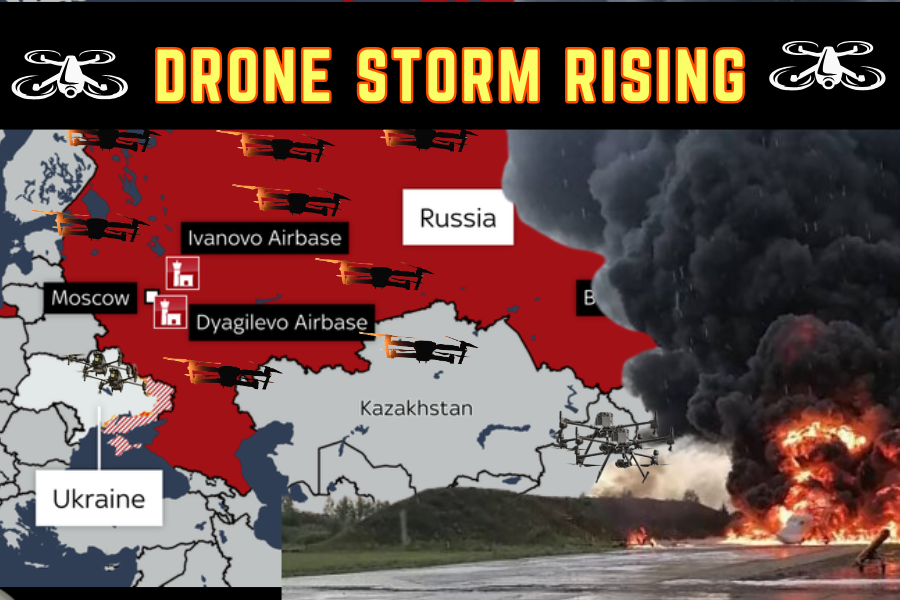(By Khalid Masood)
The recent Ukrainian drone attacks on Russian air bases, notably the June 1, 2025, strikes on Olenya and Belaya airfields, highlight the emerging threat of low-cost, high-volume drone swarms capable of overwhelming sophisticated air defences and destroying high-value assets like strategic bombers (The Guardian, Jun 2, 2025). Ukraine’s operation, codenamed “Pavutyna,” used 117 first-person-view (FPV) drones launched from trucks to hit over 40 aircraft, causing $7 billion in damages (Kyiv Independent, Jun 2, 2025). This tactic, leveraging cheap drones for precision strikes, poses a significant challenge for nations like Pakistan, especially given India’s collaboration with Israel to develop indigenous drones, including loitering munitions like the IAI Harop (The War Zone, May 9, 2025). India’s potential to deploy large-scale drone swarms could strain Pakistan’s limited air defence (AD) systems, risking heavy losses. Below is a strategic analysis of Pakistan’s vulnerabilities and actionable measures to counter this threat, drawing on the 2025 Indo-Pak war context, BeiDou’s role, and Ukraine’s drone warfare lessons. Below is a detailed account of the attack contextualized with Pakistan’s interest in countering similar drone swarm threats from India.
Details of the Ukrainian Drone Attack on Russian Air Bases (June 1, 2025)
The Ukrainian drone attack on June 1, 2025, codenamed Operation Pavutyna (“Spiderweb“), targeted Russian strategic air bases, marking one of the most audacious and damaging strikes of the Russo-Ukrainian War. Executed by the Security Service of Ukraine (SBU) under the oversight of President Volodymyr Zelenskyy and SBU chief Lt. Gen. Vasyl Maliuk, the operation struck five airfields deep inside Russian territory, damaging or destroying over 40 aircraft, including strategic bombers critical to Russia’s long-range strike capabilities.
1. Overview and Objectives
- Date and Scale: Launched on June 1, 2025, the attack involved 117 first-person view (FPV) drones, targeting five Russian air bases: Olenya (Murmansk), Belaya (Irkutsk), Dyagilevo (Ryazan), Ivanovo Severny (Ivanovo), and Ukrainka (Amur) (Web:9,14,19). It was Ukraine’s longest-range and largest single-day drone operation, spanning three time zones and up to 4,300 km from Ukraine’s border (Web:9, 11).
- Objective: Degrade Russia’s strategic aviation, particularly Tu-95MS, Tu-22M3, and Tu-160 bombers, used for cruise missile attacks on Ukrainian cities, and A-50 airborne early warning drones (Web:1,3,6). The SBU aimed to disrupt Russia’s ability to conduct long-range strikes, with damages estimated at $7 billion, affecting 34% of Russia’s strategic cruise missile carriers (Web:15,19).
- Timing: Conducted just before peace talks in Istanbul on June 2, 2025, the attack likely aimed to strengthen Ukraine’s negotiating position (Web:2,11,20). Zelenskyy called it an “absolutely brilliant” operation, planned over 18 months (Web:3,7).
2. Targets and Damage
- Olenya Air Base (Murmansk, 1,000 km from Ukraine):
- Hosted 40 Tu-22M3, 11 Tu-95MS, and 5 An-12 aircraft on May 26 (Web:4,16).
- Damage: Satellite imagery and OSINT confirmed 4 Tu-95MS destroyed, 1 Tu-95 likely damaged, and 1 An-12 destroyed (Web:14,18). Videos showed burning Tu-95s with secondary explosions (Web:6,10).
- Impact: Reduced Russia’s Arctic-based missile launch capacity (Web:5).
- Belaya Air Base (Irkutsk, 4,300 km from Ukraine):
- Hosted 35 Tu-22M3, 6 Tu-95MS, 7 Tu-160, and other aircraft on May 31 (Web:4,9).
- Damage: OSINT verified 3 Tu-95MS destroyed, 1 Tu-95 damaged, 1 Tu-22M3 destroyed, and 3 Tu-22M3 likely destroyed (Web:9,18,19). Footage showed large fires and plumes of smoke (Web:10,15).
- Significance: First Ukrainian drone strike in Siberia, highlighting Ukraine’s deep-strike capability (Web:9,11).
- Other Bases:
- Dyagilevo (Ryazan) and Ivanovo Severny (Ivanovo): Targeted but unconfirmed damage, though SBU claimed hits (Web:9,15).
- Ukrainka (Amur): Attack failed when a drone-carrying truck exploded prematurely (Web:9,21).
- Total Damage: Ukrainian sources claimed 41 aircraft hit, including Tu-95, Tu-22M3, Tu-160, and A-50 (Web:10,20). Russia admitted fires at Olenya and Belaya but claimed no casualties and repelled attacks at three bases (Web:9,11).
3. Execution and Logistics
- Methodology: The SBU smuggled FPV drones into Russia, concealing them in wooden cabins on trucks (Web:1,7,10). At the attack moment, remotely activated roofs opened, launching drones from sites near airfields (Web:6,11,15). This tactic bypassed Russian air defences, including Pantsir-S1 systems (Web:14).
- Drone Technology:
- FPV Drones: Costing ~$500 each, equipped with real-time video and AI trained on 3D scans of Soviet aircraft (e.g., Tu-95MS) for precision targeting (Web:4,7). Some drones navigated autonomously before manual terminal guidance (Web:14).
- Range: Ukraine developed drones with a 3,000 km range by March 2025, likely extended for Belaya (Web:1,13).
- Operational Secrecy: The SBU operated an “office” near a Russian FSB headquarters, showcasing audacious intelligence penetration (Web:4,9). Drones and trucks were prepositioned over 18 months (Web:7,15).
- Local Impact: Residents near Olenya reported a truck driver detained, unaware of his cargo (Web:7,9). In Irkutsk, Governor Igor Kobzev confirmed a military unit attack in Sredny village (Web:10,11).
4. Russian Response
- Official Statement: Russia’s Ministry of Defence labeled the attack a “terrorist act,” confirming fires at Olenya and Belaya but claiming no casualties and detaining participants (Web:1,9,11). Attacks on Ivanovo, Ryazan, and Amur were reportedly repelled (Web:8,18).
- Downplayed Losses: Russian Telegram channels like Fighterbomber claimed single-digit aircraft losses, denying 34% fleet damage (Web:14). Military Chronicle noted some planes were empty during maintenance, reducing impact (Web:14).
- Countermeasures: Air defences and emergency services were mobilized, with Murmansk Governor Andrey Chibis urging locals not to share footage (Web:18). Detained truck drivers were questioned (Web:9).
5. Strategic Implications
- Russia’s Losses: The destruction of Cold War-era bombers, no longer in production, and rare A-50s limits Russia’s long-range strike and AWACS capabilities (Web:9,18). The Institute for the Study of War noted temporary constraints on Russia’s missile launches (Web:9).
- Ukraine’s Innovation: The attack showcased Ukraine’s advancements in drone warfare, logistics, and intelligence, drawing comparisons to Mossad operations (Web:7). Cost-effectiveness ($500 drones vs. $75M bombers) underscores asymmetric warfare’s impact (Web:7,10).
- Geopolitical Context: Timed before Istanbul peace talks, the strike signaled Ukraine’s resolve, complicating Russia’s position (Web:8,20). Zelenskyy’s claim of not informing the U.S. suggests independent action (Web:13,17).
- Nuclear Triad Concerns: Strikes on nuclear-capable bombers raised questions about Russia’s nuclear response threshold, though analysts deemed escalation unlikely (Web:18).
Pakistan’s Vulnerabilities
- Limited Air Defence Capacity: Pakistan’s AD network, comprising HQ-9, LY-80, FM-90 systems and SHORADS like MANPAD missiles &35 Oerlikon AD guns, is robust but finite, with coverage concentrated around key cities like Lahore and Karachi (Armyrecognition.com, May 12, 2025) and well as strategic assets. A swarm of hundreds of drones, as seen in Ukraine’s attack, could saturate these systems, depleting missile stocks or exploiting gaps.
- High-Value Asset Exposure: Airbases like PAF Noor Khan, Musaaf, Masroor and Jacobabad and Shorkot housing JF-17s and J-10Cs, lack sufficient hardened shelters, making them vulnerable to precision drone strikes (Le Monde, May 8, 2025). The 2025 war exposed damage to Adampur/Sirsa bases of IAF and Bolari of PAF using drones and missiles underscoring this risk (Al Jazeera, May 7, 2025).
- India’s Drone Advantage: India’s collaboration with Israel has produced Harop loitering munitions, capable of SEAD/DEAD missions with 600-mile range and 50-pound warheads (The War Zone, May 9, 2025). India’s indigenous swarm drone programs, inspired by Israel’s expertise, could deploy hundreds of low-cost UAVs, overwhelming Pakistan’s radar and missile defences (TheLegateIN, X, Oct 19, 2023).
- EW and Jamming Gaps: While Pakistan’s KORAL and HQ-17AE jammers disrupted Indian drones in 2025, sustained swarm attacks could overload these systems, especially if India employs AI-enabled drones with autonomous targeting, as tested in Ukraine (Euromaidan Press, Jun 2, 2025).
Strategic Measures for Pakistan
To counter India’s potential drone swarm threat, Pakistan must adopt a multi-layered, cost-effective defence strategy, leveraging lessons from Ukraine, its BeiDou integration, and regional alliances. Below are key recommendations:
1. Enhance Air Defence Architecture
- Layered AD Systems: In addition to already held SHORADS, Pakistan must deploy short-range systems like Pantsir-S1 or Tor-M2, optimized for low-altitude drone interception, to complement HQ-9’s long-range coverage (CSIS, Feb 19, 2025). These systems, costing $14–20M per unit, can engage multiple targets simultaneously, reducing missile depletion against swarms.
- Mobile Counter-Drone Units: Emulate Ukraine’s truck-based FPV drone launches by developing mobile counter-drone teams equipped with RF jammers and laser-based systems like China’s LW-30 (Navalpost.com, May 24, 2021). These units can disrupt drone data links within 150 km, as seen in 2025 (iwasnevrhere_, X, May 8, 2025).
- Hardened Shelters: Construct reinforced hangars at airbases like PAF Kamra and Mushaf, prioritizing JF-17 and J-10C protection. Ukraine’s strikes exposed Russia’s lack of shelters, a lesson Pakistan must heed (The War Zone, Jun 1, 2025).
2. Leverage BeiDou for EW and C4ISR
- BeiDou-Guided Countermeasures: Utilize BeiDou’s jam-resistant, 10 cm-accurate navigation to guide counter-drone swarms and precision interceptors (Nature.com, May 19, 2025). Its multiband signals (E1, E2, E5B, E6) resisted Indian jamming in 2025, enabling real-time AD coordination (Clashreport, Apr 29, 2025).
- AI-Enhanced Detection: Integrate BeiDou with AI-driven radar systems, as tested in China’s IoT networks, to detect and prioritize drone threats (Mdpi.com, 2021). AI can reduce false positives, critical against swarms of 500+ drones, as speculated in Pakistani reports (manamuntu, X, May 9, 2025).
- QKD for Secure C2: Deploy BeiDou’s Quantum Key Distribution (QKD) for uncrackable command-and-control links, ensuring AD networks remain operational under Indian cyber attacks (Xinhua, May 7, 2025).
3. Develop Indigenous Counter-Drone Technology
- Low-Cost FPV Drones: Mimic Ukraine’s $500 FPV drones, launched from trucks, to create disposable counter-drone swarms (BBC, Jun 2, 2025). Pakistan’s NESCOM can adapt Shahpar-II designs for anti-drone roles, costing $10,000 per unit versus India’s $50M Harops (Globalvillagespace.com, Mar 21, 2022).
- Directed Energy Weapons: Invest in Chinese LW-30 laser systems, capable of neutralizing drones at 25 km for $1 per shot, far cheaper than $1M SAMs (CSIS, Feb 19, 2025). These can be deployed around airbases, reducing reliance on missile stocks.
- SIGINT and Jamming: Expand use of KORAL trucks and Chinese HQ-17AE jammers to disrupt Indian drone data links, as demonstrated in 2025 (iwasnevrhere_, X, May 8, 2025). Turkish decryption modules can counter Israeli drone algorithms (iwasnevrhere_, X, May 7, 2025).
4. Strengthen Regional Alliances
- China’s Technical Support: Deepen Sino-Pak collaboration to access BeiDou’s LEO layer, promising 5 cm accuracy by 2027, and RTK systems for sub-3-minute convergence (Satellite-navigation.springeropen.com, Jun 24, 2024). China’s 2025 aid, including J-10Cs, can extend to drone defence tech (DerekJGrossman, X, May 23, 2025).
- Turkish Drone Expertise: Leverage Turkey’s Bayraktar TB2 experience, used in Ukraine, to develop anti-swarm tactics (Wikipedia, Jun 1, 2025). Turkey’s KORAL jammers, tested against Israeli drones, can enhance Pakistan’s EW capabilities (iwasnevrhere_, X, May 7, 2025).
- OIC and BRI Networks: Secure funding from Saudi Arabia and Qatar for AD modernization, using BeiDou’s BRI integration as a diplomatic lever (Wikipedia, Jan 26, 2025).
5. Doctrinal and Operational Reforms
- Swarm Defence Doctrine: Develop a doctrine prioritizing early detection via ZDK-03 AEW aircraft and BeiDou-linked radars, followed by layered interception (iwasnevrhere_, X, May 8, 2025). Train operators to counter AI-enabled drones, as seen in Ukraine (Euromaidan Press, Jun 2, 2025).
- Deception Tactics: Use decoy airfields and GPS spoofing, enabled by BeiDou’s back-scatter capabilities, to mislead Indian drones (iwasnevrhere_, X, May 8, 2025). Ukraine’s success in hiding operatives near Russian FSB offices suggests covert deception’s value (Kyiv Independent, Jun 2, 2025).
- Rapid Response Units: Establish rapid-reaction squadrons with JF-17Cs equipped with PL-15 missiles and jamming pods to intercept drone swarms before they reach airbases (zhao_dashuai, X, May 19, 2025).
6. Economic and Industrial Fortification
- Domestic Drone Production: Scale up NESCOM’s production of Burraq and Shahpar-II drones, integrating BeiDou for counter-swarm roles, to reduce reliance on imports (Al Jazeera, May 7, 2025). A $500M investment could yield 1,000 units annually, per Chinese models (Globalvillagespace.com, Mar 21, 2022).
- Economic Resilience: Address 8% inflation and $340B GDP constraints by prioritizing cost-effective systems like lasers over $100M SAMs (India Today, May 20, 2025). CPEC’s BeiDou-monitored infrastructure can attract Chinese investment for AD upgrades (Thesvi.org, Aug 30, 2020).
Conclusion
India’s collaboration with Israel to produce large-scale drones, potentially deployed in swarms, poses a severe threat to Pakistan’s air defences, as demonstrated by Ukraine’s 2025 strikes on Russia. Pakistan can mitigate this risk by enhancing its AD architecture with layered systems and hardened shelters, leveraging BeiDou’s EW and C4ISR capabilities, developing indigenous counter-drone technologies, strengthening alliances with China and Turkey, and adopting a swarm defence doctrine. Economic fortification and domestic production will ensure sustainability. As Ukraine’s “Pavutyna” operation proved, preparation and innovation can turn the tide against overwhelming odds. Pakistan must act swiftly to transform its vulnerabilities into a resilient defence, ensuring its skies remain impregnable against India’s looming drone armada.








The notion that Russia – Ukraine war could gradually de-escalate is now being seriously challenged. It’s evolving—and with each phase, the risk of a broader, less predictable conflict increases. If Russia decides to escalate, potentially with backing from countries like Iran or North Korea, the consequences could stretch far beyond Eastern Europe. Ukraine’s latest attack might not end the war, but it has shattered the illusion that this crisis can be contained or resolved through patience alone.